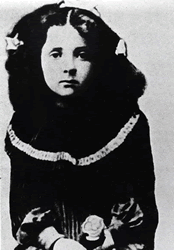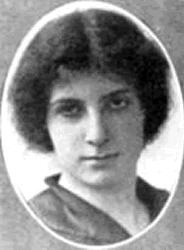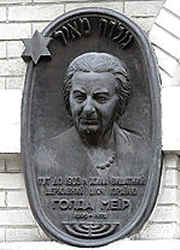The First known picture of Golda Meir taken in Pinsk C. 1904.
1910 census;
Name: Golda Mabowetz
Age in 1910: 12
Estimated Birth Year: abt 1898
Birthplace: Russia
Relation to Head of House: Daughter
Father's Name: Morris
Father's Birth Place: Russia
Mother's Name: Bella
Mother's Birth Place: Russia
Home in 1910: Milwaukee Ward 6, Milwaukee, Wisconsin
Marital Status: Single
Race: White
Gender: Female
Year of Immigration: 1906 her father came in 1903.
Neighbors: View others on page
Household Members:
Name Age
Morris Mabowetz 46
Bella Mabowetz 43
Golda Mabowetz 12
Clara Mabowetz 8
Louis Sabelinsky 28
In her memoirs she remembers Pinsk, the city of her childhood. Jews accounted for a large part of the population of Belarusan cities. . At the beginning of the 20th century 14 per cent of the total population in Belarus were Jews.
http://www.time.com/time/magazine/article/0,9171,913754-1,00.html
There are few odder couples than Pope Paul VI and Golda Meir. The disparity overwhelmed even Mrs. Meir two years ago as she prepared for the first official meeting between an Israeli Premier and a Roman Catholic Pontiff. "Imagine," she remarked to her aides. "I, the daughter of Moshe Mabovitch, who was just an ordinary carpenter, am actually on my way to the Holy See to meet the Pope." "Don't forget," retorted her assistant, "carpenters have a special standing there." Now that Mrs. Meir has written her memoirs, this image of the Yiddisher mama as world figure—"I, Golda Meir, from Pinsk, Milwaukee and Tel Aviv"—dominates. The progress of that pique remains a compelling narrative.
The carpenter's daughter started life in pogrom-ridden Russia. The family was nonreligious but proud of its Jewishness. God did not choose the Jews as his people, the young Golda decided; rather, the Jews chose God: "The first people in history to have done something truly revolutionary." From Pinsk the Mabovitches emigrated to Milwaukee. At the Fourth Street School, still standing in the shadow of a brewery, Golda learned English to complement the Yiddish spoken at home and the Hebrew she would later speak with an accent. She yearned to become a schoolteacher, but Labor Zionism exerted a stronger pull. In 1921 she emigrated for the final time to the Yishuv, the Land of Israel. for the rest go to; http://www.time.com/time/magazine/article/0,9171,913754-1,00.html
Meir was born as Golda Mabovitch in Kiev in the Russian Empire (today Ukraine), to Blume Naidtich and Moshe Mabovitch, a carpenter. Later, the family moved to Pinsk. Golda wrote in her autobiography that her earliest memories were of her father boarding up the front door in response to rumors of an imminent pogrom. . She had two sisters, Sheyna and Tzipke. Five other siblings died in childhood. Golda was especially close to Sheyna. Moshe Mabovitch left for the United States in 1903 and the family followed in 1906.[3]
Emigration to the United States
The family settled in Milwaukee, Wisconsin, where her father found a job as a carpenter and her mother ran a grocery store. At the age of eight, she was already put in charge of watching the store when her mother went to the market for supplies.
Golda attended the Fourth Street School (now Golda Meir School) across from the Schlitz Brewing Complex from 1906 to 1912. A leader early on, Golda organized a fundraiser to pay for her classmates' textbooks. After forming the American Young Sisters Society, she rented a hall and scheduled a public meeting for the event. When she began school, she did not know English, but she graduated as valedictorian of her class.
At 14, she went to North Division High School and worked part-time. Her mother wanted her to leave school and marry, but she rebelled. She bought a train ticket to Denver, Colorado, and went to live with her married sister, Sheyna Korngold. The Korngolds held intellectual evenings at their home where Meir was exposed to debates on Zionism, literature, women's suffrage, trade unionism and more. In her autobiography, she wrote: "To the extent that my own future convictions were shaped and given form...those talk-filled nights in Denver played a considerable role." In Denver, she also met Morris Meyerson, a sign painter, whom she married at the age of 19.[4]
In 1913, Golda returned to her high school in Milwaukee, graduating in 1915. While there, she became an active member of the Zionist youth movement, Habonim (now Habonim Dror). She spoke at public meetings, embraced Socialist Zionism and hosted visitors from Palestine.
After graduating from the Milwaukee State Normal School (a predecessor of the University of Wisconsin-Milwaukee), she taught in public schools. She formally joined the Labour Zionist Organization in 1915.
Golda and Morris married in 1917 and began planning to make aliyah (immigration to the Land of Israel, then a part of the Ottoman Empire). They made the move to Palestine in 1921, together with Golda's sister Sheyna.
Aliyah to Palestine
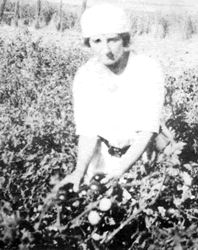
Golda Meir in the fields at Kibbutz Merhavia
In Palestine, the couple decided to join a kibbutz. Their first application, to Kibbutz Merhavia in the Jezreel Valley, was rejected, but this decision was later overturned. Golda's duties included picking almonds, planting trees, working in the chicken coops and running the kitchen. Recognizing her leadership abilities, the kibbutz chose her as its representative to the Histadrut, the General Federation of Labour. In 1924, Golda and her husband left the kibbutz life and lived briefly in Tel Aviv before settling in Jerusalem. There they had two children, a son Menachem (born 1924) and a daughter Sarah (born 1926). In 1928, Golda was elected secretary of Moetzet HaPoalot (Working Women's Council), which required her to spend two years (1932-34) as an emissary in the United States.[5] The children went with her, but Morris stayed in Jerusalem. Morris and Golda grew apart but never divorced. Morris died in 1951.
[edit] Histadrut activities
In 1934, when Meir returned from the United States, she joined the Executive Committee of the Histadrut and moved up the ranks to become head of its Political Department. This appointment was important training for her future role in Israeli leadership.[6]
[edit] Pre-state political role
In June 1946, the British cracked down on the Zionist movement in Palestine, arresting many leaders of the Jewish Yishuv. Meir took over as acting head of the Political Department of the Jewish Agency during the incarceration of Moshe Sharett. Thus she became the principal negotiator between the Jews in Palestine and the British Mandatory authorities. After his release, Sharett went to the United States to attend talks on the UN Partition Plan, leaving Meir to head the Political Department until the establishment of the state in 1948.[7]
On May 10, 1948, four days before the official establishment of the state, Meir traveled to Amman disguised as an Arab woman for a secret meeting with King Abdullah of TransJordan at which she urged him not to join the other Arab countries in attacking the Jews. Abdullah asked her not to hurry to proclaim a state. Golda, known for her acerbic wit, replied: "We've been waiting for 2,000 years. Is that hurrying?"[8]
Ministerial positions
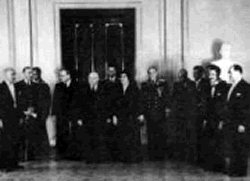
Ambassador Golda Meir presenting her credentials at the Kremlin, September 10, 1948
Meir was one of twenty-four signatories (two of them women) of the Israeli declaration of independence on May 14, 1948. She later recalled, "After I signed, I cried. When I studied American history as a schoolgirl and I read about those who signed the Declaration of Independence, I couldn't imagine these were real people doing something real. And there I was sitting down and signing a declaration of establishment."
Israel was attacked the next day by the joint armies of Egypt, Syria, Lebanon, Transjordan, and Iraq in the Israeli War of Independence. Armed with the first Israeli-issued passport,[9][10] Golda was sent to the United States to raise money for the new state.
[edit] Ambassador to Moscow
Upon returning from the United States, Meir was appointed Israel's first ambassador to the Soviet Union. During her brief stint there, which ended in 1949, she attended high holiday services at the synagogue in Moscow, where she was mobbed by thousands of Russian Jews chanting her name. Despite Stalin's repression of Jewish identity in the Soviet Union, the turnout showed that the Jewish community was still strong and united. The Israeli 10,000 shekel banknote issued in November 1984 bore a portrait of Golda on one side and the image of the crowd that turned out to cheer her in Moscow, on the other[11]
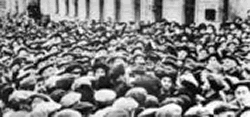
Jewish High Holidays in Moscow, 1948: Golda Meir in the crowd (est. 50,000) of Soviet Jews who gathered to meet her
Labor minister
In 1949, Meir was elected to the Knesset as a member of Mapai and served continuously until 1974. From 1949 to 1956, she served as Minister of Labor, introducing major housing and road construction projects.[12]
Foreign minister
In 1956, she became Foreign Minister under Prime Minister David Ben-Gurion. Her predecessor, Moshe Sharett, had asked all members of the foreign service to Hebraicize their last names. Upon her appointment as foreign minister, she shortened "Meyerson" to "Meir," which means "illuminate."
As foreign minister, Meir promoted ties with the newly-established states in Africa in an effort to gain allies in the international community.[13]But she also believed that Israel had experience in nation-building that could be a model for the Africans. In her autobiography, she wrote: "Like them, we had shaken off foreign rule; like them, we had to learn for ourselves how to reclaim the land, how to increase the yields of our crops, how to irrigate, how to raise poultry, how to live together, and how to defend ourselves." Israel could be a role model because it "had been forced to find solutions to the kinds of problems that large, wealthy, powerful states had never encountered."[14]
In the early 1960s, Meir was diagnosed with lymphoma. In January 1966, she retired from the Foreign Ministry, citing exhaustion and ill health, but soon returned to public life as secretary general of Mapai, supporting the prime minister, Levi Eshkol, in party conflicts.[15]
Prime Ministership
After Levi Eshkol's sudden death on February 26, 1969, the party elected Meir as his successor.[16]Meir came out of retirement to take office on March 17, 1969, serving as prime minister until 1974. Meir maintained the coalition government formed in 1967, after the Six Day War, in which Mapai merged with two other parties (Rafi and Ahdut HaAvoda) to form the Israel Labor party.[17]
In 1969 and the early 1970s, Meir met with many world leaders to promote her vision of peace in the Middle East, including Richard Nixon(1969), Nicolae Ceausescu (1972) and Pope Paul VI (1973). In 1973, she hosted the chancellor of Germany, Willy Brandt in Israel.[18]
In August 1970, Meir accepted a U.S. peace initiative that called for an end to the War of Attrition and an Israeli pledge to withdraw to "secure and recognized boundaries" in the framework of a comprehensive peace settlement. The Gahal party quit the national unity government in protest, but Meir continued to lead the remaining coalition.[19]
Munich Olympics
Main article: Operation Wrath of God
In the wake of the Munich massacre at the 1972 Summer Olympics, Meir appealed to the world to "save our citizens and condemn the unspeakable criminal acts committed."[20] Outraged at the lack of global action, she authorized the Mossad to hunt down and assassinate the Black September and PFLP operatives who took part in the massacre[21] The 1986 TV film Sword of Gideon, based on the book Vengeance: The True Story of an Israeli Counter-Terrorist Team by George Jonas, and Steven Spielberg's movie Munich (2005) were loosely based on these events.
Yom Kippur War
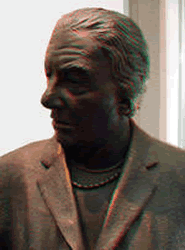
A sculpture of Golda Meir at the Richard Nixon Presidential Library and Museum, California
In the days leading up to the Yom Kippur War, Israeli intelligence was not able to determine conclusively that an attack was imminent. Six hours before the outbreak of hostilities, Meir met with Minister of Defense Moshe Dayan and general David Elazar. While Dayan continued to argue that war was unlikely, Elazar advocated launching a pre-emptive strike on Syrian forces.[22]
Meir believed that Israel could not depend on European countries to supply Israel with military equipment and the only country that might come to Israel's assistance was the United States. Fearing that the U.S. would be wary of intervening if Israel were perceived as initiating the hostilities, Meir decided against a pre-emptive strike. Then-U.S. Secretary of State Henry Kissinger later confirmed Meir's assessment by stating that if Israel had launched a pre-emptive strike, Israel would not have received "so much as a nail."[citation needed]
Resignation
Following the Yom Kippur War, Meir's government was plagued by in-fighting and questions over Israel's lack of preparedness for the war. The Agranat Commission appointed to investigate the war cleared her of direct responsibility, and her party won the elections in December 1973, but she resigned on April 11, 1974, bowing to what she felt was the "will of the people."[23]Yitzhak Rabin succeeded her on June 3, 1974.
In 1975, Meir was awarded the Israel Prize for her special contribution to the State of Israel.[24]
Death
On December 8, 1978, Golda Meir died of cancer in Jerusalem at the age of 80. She was buried on Mount Herzl in Jerusalem on December 12, 1978.
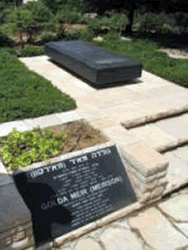
Golda Meir's grave on Mt. Herzl
Portrayals in film and theater
Golda Meir's story has been the subject of many fictionalized portrayals over the years. In 1977, Anne Bancroft played Meir in William Gibson's Broadway play Golda. Ingrid Bergman and the Australian actress Judy Davis played Meir in the television film A Woman Called Golda (1982). In 2003, the American Jewish actress Tovah Feldshuh portrayed her on Broadway in Golda's Balcony, Gibson's second play about Meir's life. The one-woman show was controversial in its implication that Meir considered using nuclear weapons during the Yom Kippur War. Valerie Harper portrayed her in the touring company and in the film version of Golda's Balcony.[citation needed] In 2005, actress Lynn Cohen portrayed Meir in Steven Spielberg's film Munich.
Commemoration
* Golda Meir Center for Political Leadership at Metropolitan State College of Denver[25]
* Golda Meir House, Denver, Colorado[26][27]
* Golda Meir School, Milwaukee, Wisconsin[28]
* Golda Meir Library
* Golda Meir Boulevard, Jerusalem, Israel
* Golda Meir Center for the Performing Arts, Tel Aviv
Published Work
* This is Our Strength (1962) - Golda Meir's collected papers
* My Father's House (1972)
* Meir, Golda (1975). My Life. Putnam. ISBN 0-399-11669-9.
